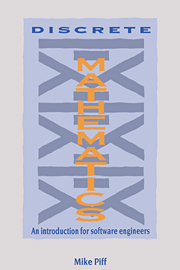1 - Introduction
Published online by Cambridge University Press: 05 June 2012
Summary
Discrete mathematics
Discrete mathematics is the study of those parts of mathematics which do not require any knowledge of limits, convergence, differentiation, and so on. It encompasses most of the foundations of mathematics, such as logic, set theory, relations, and also graph theory, formal language theory and an indeterminate chunk of abstract algebra.
The boundaries are necessarily vague, as they are in any subject, and we can never be sure, as our study progresses, that we will not need some result from another area. Anyone studying the time complexity of sorting algorithms would find it difficult not to use some ideas from the calculus; both logic and formal languages subsume the whole of mathematics; the study of finite error correcting codes leads into some sophisticated uses of matrices and polynomial algebras.
Mathematics provides us with a way of describing the so called ‘real world’ in an accurate, concise and unambiguous way. We extract the properties which we wish to describe, write down a few mathematical relations, and then work algebraically with those relations. As long as the mathematics and the object of our study have those common properties, any deduction we make in the mathematical model can be translated back to the real world.
It does not matter whether the mathematical description is close to the way a task is implemented. A common mistake is to think in terms of concrete realizations rather than properties.
Information
- Type
- Chapter
- Information
- Discrete MathematicsAn Introduction for Software Engineers, pp. 1 - 3Publisher: Cambridge University PressPrint publication year: 1991
